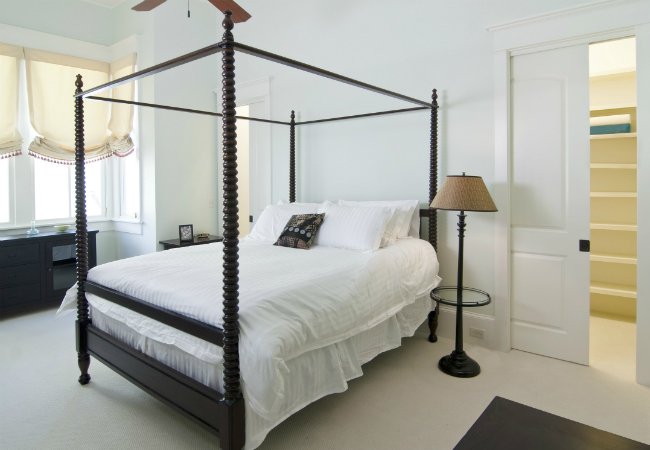We may earn revenue from the products available on this page and participate in affiliate programs. Learn More ›
What’s true about fashion can be applied to interior design: If you wait long enough, the old styles come back in vogue. Pocket doors were ubiquitous in old Victorian homes, where they were often used to separate large indoor spaces like living rooms and dining rooms.
After fading from the architectural scene for a century or so, the pocket door has resurfaced, finding new fans for its space-saving functions and retro forms.
Before you start cutting into walls and installing a pocket door of your own, however, make sure you understand its mechanics to decide whether it’s the best choice for your home.
What is a pocket door?
A pocket door is a sliding door that neatly tucks into a wall or divider. It glides on a track, so you can close off a room for more privacy or open it up to connect spaces. A pocket door is ideal for small rooms or areas where a standard swinging door would not operate correctly or would take up too much space.
Since pocket doors hang on a track and slide into the recess of a wall, the doors themselves are typically thin, lightweight, and don’t prevent all sound from traveling between rooms. Though you can hire a handyperson, installing sliding pocket doors is a fairly simple DIY project!
Here are some of the most popular locations to install a pocket door system in your home:
- Master bedroom: If your master suite has an open bathroom design, installing a single pocket door between the bedroom and bathroom would certainly add more privacy for when multiple people are using the space at the same time.
- Laundry room: Older homes were often not built with a dedicated laundry room, so homeowners have had to turn a nook in the kitchen or a small spare bedroom into a laundry space. You can make your laundry room look nicer and reduce noise by installing a pocket door system into an existing wall.
- Pantry: A single pocket door is the most popular choice when it comes to improving your home’s pantry. Choose a pocket door kit that fits the existing look and feel of your kitchen design.
- Home office: Looking to separate yourself from the family and get a moment of peace when you work from home? Install a pocket door system right into your existing wall to increase productivity.
- Kitchen and dining room: Most homes have their kitchen and dining room connected with an open design. But if you would rather have the option to divide the spaces when prepping a big meal or hosting a small get-together, installing a pocket door would give you the best of both worlds.
Advantages of Pocket Doors
Rather than swinging open and shut, the pocket door slides into a hidden wall compartment to allow entry and exit. This style is perfect for rooms where you don’t have clearance for a swinging door or where you want to make the best use of space.
Replacing a swinging door with a pocket door recovers at least 10 square feet of floor space around the door and frees up real estate on the walls for fixtures or artwork that would otherwise be hidden behind a traditional door when opened. Moreover, as a pocket door withdraws into the wall, it’s more inconspicuous than its trendy cousin, the sliding barn door.
Pocket doors also work well where homeowners want a flexible partition. If a door rarely needs to be closed, or if you’re trying to isolate a smaller room—say, the laundry room, office, or pantry—from a larger open-plan area, pocket doors pull out when you need them and disappear when you don’t.
Some designs can be adapted to modern uses. A Dutch pocket door, for example, extends only half the height of a standard 80-inch-tall door and pulls out from one side or both, making it a great alternative to those unsightly or rickety safety gates that protect pets or children.
Disadvantages of Pocket Doors
Unfortunately, pocket doors don’t work everywhere. Before moving ahead with the project, consider these potential complications: locking limitations, door frame stability, and wall space requirements.
Pocket doors don’t seal a room as tightly as a traditional swinging door, and the typical locking mechanism is flimsier than a tubular latch or deadbolt. (If the occupants of your home can learn that a closed-door speaks for itself, you might skip the locks altogether and shop for something more creative. Some people use cabinet pulls or even antlers to make an otherwise pedestrian piece of hardware stand out.)
Should the flimsier seal not be problematic for your household, move on to examine the wall in which you intend to fit the door. Just as a traditional door requires clearance within a room to swing open and closed, a pocket door requires clearance inside a wall to open and close.
Be sure to consult your local building code to avoid any missteps. For example, it is likely prohibited to install a pocket door in a load-bearing wall without first installing the appropriate alternative support before removing studs.
Consider the work and expense involved before beginning demolition. Another deal-breaker: If the walls abutting the entryway are too short or cluttered with electrical or plumbing fixtures or built-in shelves or cabinets, there won’t be enough room for the pocket door to slide inside the wall.
If you are thinking of taking on a pocket door installation project yourself, make sure to consider things like electrical wires, studs, and even plumbing pipes that exist behind your drywall before you start. Replacing an interior door or adding a new one all together requires the right tools and knowledge before taking on the task.

Space Requirements for Pocket Doors
A pocket door requires a “sleeve” inside the wall to retract into. For a traditional 32-inch-wide interior door, you’ll need at least 66 inches of linear wall space: 32 inches for the door and the rest for the housing. (Note: It’s OK if this sleeve intersects with another wall, but you might need special hardware to reinforce that juncture if a supportive stud needs to be removed.)
The existing wall should also be thicker than 4 inches, as the standard pocket door thickness is about 2 inches. Based on these measurements, you will be able to choose the right pocket door kit for your home.
Another measurement to take during the planning phase is that of the doorway itself. Generally, when it’s open, a pocket door disappears entirely and remains accessible via a recessed pull on the leading edge.
If, however, you choose to install handles on the sides of the door, it won’t retract all the way, but it will be a little easier to open and close. Ask yourself: Is the doorway wide enough to sacrifice a few inches for that more convenient door pull, or do I need the full width of the walkway because it’s a high-traffic area?
Weigh the pros and cons to having it jut out some—remember, a couple of inches your door eats into your walkway may give you wiggle room by requiring less than the standard 66 inches of linear wall space to house it when retracted.
Next, you’ll have to assess what else shares the wall space where the pocket door cage will go and how difficult these fixtures would be to move. The wall is a poor candidate for a pocket door if:
- Pipes or electrical wires run through it. Rerouting pipes and wires are beyond the skill set of the average do-it-yourselfer and add to the installation cost. As well, because of the depth of the electrical box in which it’s housed, you won’t have room for a standard switch or outlet in the pocket door wall.
- You want to hang a heavy frame using a wall anchor or fastener that penetrates far into ½- to ¾-inch drywall. This will impede the door’s movement and gouge the door.
- You need to install an assist bar or fixture that requires heavy-duty wall anchors. The pocket door cage includes split studs that can support a towel bar or toilet-paper holder but won’t meet the standards for a weight-bearing fixture. If the pocket door frame uses steel studs rather than wood, you’ll have to attach the wallboard to the bottom plate below the pocket door compartment, which further limits the use of wall space.

Pocket Door Installation: What to Expect
Once you have measured and checked for dangers behind your walls, it’s time to install your pocket door system!
First thing—do yourself a favor and buy a pocket door installation kit or prefabricated frame—it simplifies the project by orders of magnitude. Kits come with all the hardware, including the track system from which the door hangs; premade units are just what they sound like, with all the parts where they belong. Both include detailed instructions that minimize mistakes. The prefabricated frames fit standard door sizes, but a competent do-it-yourselfer can customize them.
Here are a few things that you should expect to encounter as you install your sliding pocket doors:
- Assuming you’re not fortunate enough to be installing a pocket door in a home that’s under construction, expect to remove the drywall on both sides of the wall where the pocket door will go.
- Remove the studs as well to make way for a new door header and pocket door framework.
- If your home was built before 1978 and it’s likely that the existing walls were finished with lead-based paints, you need to follow protocol to dispose of the materials you’re ripping out.
- Most pocket doors hang from recessed tracks, with the top of the door attached to a trolley system and glides that keep the door centered as it moves. But some are mounted from the ground—or the ground and ceiling—if the door is broader than usual. A ground-mounted system can present a tripping hazard and limit accessibility, but you can find recessed tracks that eliminate this problem. Expect to spend more on this setup.
- After installing a pocket door’s frame, you’ll hang the door and adjust it, so it’s plumb. Remove the door temporarily to paint it, install any recessed hardware, and then remount it before hanging new drywall on both sides of the wall. Tape, sand, and paint your walls; then finish them by reinstalling your baseboards and other trim. The last step is to install the jambs.
Once you start using your new pocket door, you’ll wonder why home builders ever abandoned such an ingenious, multipurpose feature. With the ability to free up floor space and perform its disappearing act, this home addition is downright magical.
FAQs
Pocket doors are ideal for spaces that you want to section off but don’t want to give up the square footage of a room that’s required for a traditional swinging door. Some common areas where a pocket door works wonderfully are: master suite, laundry room, pantry, home office, between a kitchen and dining room.
Whether or not you should install a pocket door system depends on your confidence with DIY projects. Since pocket doors go into existing walls, you need to consider your skills, the expense involved, and consult building codes before beginning demolition.
For a traditional 32-inch-wide interior door, you’ll need at least 66 inches of linear wall space: 32 inches for the door and the rest for the housing.


